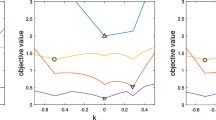Abstract
A weighted L 2,1 minimization is proposed for signal reconstruction from a limited number of measurements when partial support information is known. The reconstruction error bound of the weighted L 2,1 minimization is obtained and our sufficient condition is shown to be better than \(\delta _{3K}<{\frac{1}{\sqrt{3}}}\) if the estimated support is at least 50 % accurate. Experiments are given for larynx image sequence to illustrate the validity of the proposed method.




Similar content being viewed by others
Notes
The codes can be downloaded from the first author’s homepage.
References
Candès, E., Romberg, J., & Tao, T. (2000). Robust uncertainty principles: Exact signal reconstruction from highly incomplete frequency information. IEEE Transactions on Information Theory, 52(2), 489–509.
Candès, E. J., & Tao, T. (2005). Decoding by linear programming. IEEE Transactions on Information Theory, 51(12), 4203–4215.
Vaswani, N., & Lu, W. (2010). Modified-CS: Modifying compressive sensing for problems with partially known support. IEEE Transactions on Signal Processing, 58(9), 4595–4607.
Lu, W., & Vaswani, N. (2012). Regularized modified BPDN for noisy sparse reconstruction with partial erroneous support and signal value knowledge. IEEE Transactions on Signal Processing, 60(1), 182–196.
Jacques, L. (2010). A short note on compressed sensing with partially known signal support. Signal Processing, 90(12), 3308–3312.
Friedlander, M., Mansour, H., Saab, R., & Yilmaz, ö. (2012). Recovering compressively sampled signals using partial support information. IEEE Transactions on Information Theory, 58(2), 1122–1134.
Ince, T., Nacaroglu, A., & Watsuji, N. (2013). Nonconvex compressed sensing with partially known signal support. Signal Processing, 93(1), 338–344.
Blanchard, J., Cermak, M., Hanle, D., & Jing, Y. (2013). Greedy algorithms for joint sparse recovery. IEEE Transactions on Signal Processing, 62(7), 1694–1704.
Foucart, S. (2011). Recovering jointly sparse vectors via hard thresholding pursuit. In Proceedings of SampTA, Singapore.
Zou, J., Fu, Y., & Xie, S. (2012). A block fixed point continuation algorithm for block-sparse reconstruction. IEEE Signal Processing Letters, 19(6), 364–367.
He, Z., et al. (2008). CG-M-FOCUSS and its application to distributed compressed sensing. In Proceedings of advances in neural networks-ISNN, Part I, Berlin (Vol. 5263, pp. 237–245).
Candès, E. J. (2008). The restricted isometry property and its implications for compressed sensing. Comptes Rendus de l'Académie des Sciences Paris, Series I, 346, 589–592.
Foucart, S. (2011). Hard thresholding pursuit: An algorithm for compressive sensing. SIAM Journal on Numerical Analysis, 49(6), 2543–2563.
Eldar, Y., & Mishali, M. (2009). Robust recovery of signals from a structured union of subspace. IEEE Transactions on Information Theory, 55(11), 5302–5316.
Acknowledgments
This work was supported by the Scientific Research Foundation for Ph.D. of Henan Normal University (No. qd14142), the Key Scientific Research Project of Colleges and Universities in Henan Province (No. 15B120004) and National Natural Science Foundation of China, Tian Yuan Special Foundation (No. 11526081).
Author information
Authors and Affiliations
Corresponding author
Rights and permissions
About this article
Cite this article
Li, H. The Weighted L 2,1 Minimization for Partially Known Support. Wireless Pers Commun 91, 255–265 (2016). https://doi.org/10.1007/s11277-016-3458-7
Published:
Issue Date:
DOI: https://doi.org/10.1007/s11277-016-3458-7



